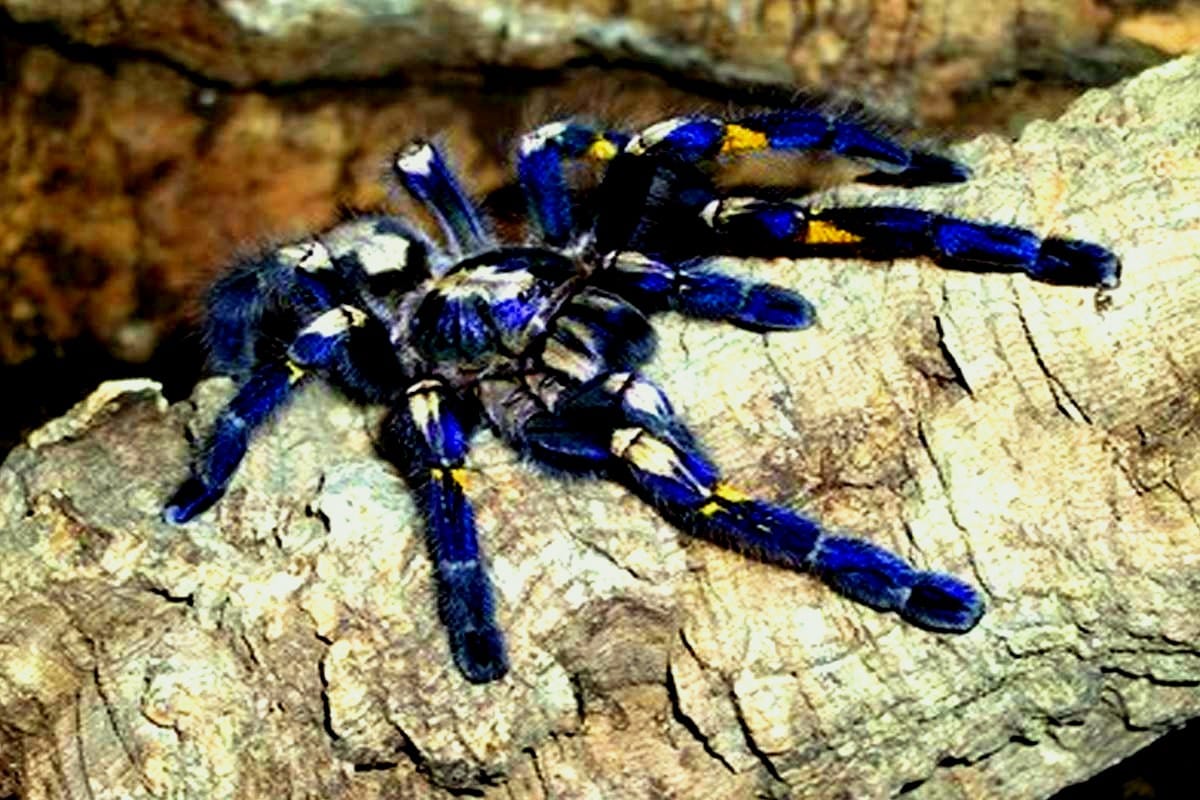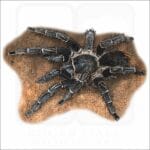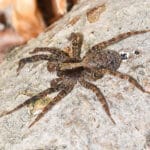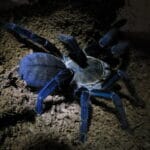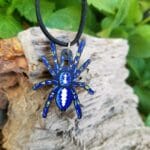Imagine a spider shimmering like a fallen piece of the night sky. That’s the Gooty sapphire ornamental tarantula (*Poecilotheria metallica*), a captivating creature native to India. This comprehensive guide explores everything from its vibrant appearance to its conservation status, offering insights into its behavior, venom, and the responsibilities of keeping one as a pet.
A Dazzling Jewel: Appearance and Identification
The Gooty sapphire tarantula is renowned for its striking metallic blue coloration, particularly prominent in adult males. Intricate yellow leg markings and fractal-like patterns further enhance its beauty. Younger spiders, however, display more subdued colors, likely for camouflage. This dramatic shift in appearance as they mature is a subject of ongoing research, but some scientists suggest it’s a protective measure against predators while they are still vulnerable.
A Forest Canopy Kingdom: Habitat and Distribution
This rare tarantula occupies a surprisingly small territory—a mere 100 square kilometers within the Eastern Ghats of Andhra Pradesh, India. They prefer the high hollows of tall trees, where they construct unusual, asymmetrical funnel-shaped webs. This limited range makes them incredibly susceptible to habitat loss due to deforestation, a significant concern for their continued survival. Further research is needed to fully map their distribution and understand the specific factors influencing their habitat selection within this restricted area.
The Arboreal Acrobat: Behavior and Diet
Living high in the canopy, the Gooty sapphire tarantula is a skilled aerial hunter. Their diet primarily consists of flying insects snared in their strategically placed webs. Unlike the solitary nature of many tarantula species, Gooty sapphires have sometimes been observed living in communal groups, a behavior that continues to intrigue researchers. Known for their quick movements and defensive nature, they react swiftly to perceived threats, likely triggered by vibrations or visual stimuli.
From Tiny Spiderling to Sapphire Giant: Lifespan and Reproduction
Female Gooty sapphires typically live much longer than their male counterparts, reaching 11 to 15 years compared to the males’ 3 to 4 years. A single female can produce thousands of spiderlings, which emerge from a silken egg sac a striking purple color. However, survival rates in the wild are probably low, with many spiderlings succumbing to predation, competition, or unfavorable environmental conditions. Ongoing research aims to better understand the factors influencing these survival rates.
Venom: Respect but Not Fear: Handling with Caution
The Gooty sapphire tarantula possesses venom capable of inflicting a painful bite. While not considered lethal to humans, the venom can cause localized pain, swelling, and possibly muscle cramps, similar to a bee sting, sometimes more intense. Research into the venom’s exact composition and effects is ongoing. It’s always wisest to admire these spiders from a safe distance, minimizing handling to avoid any potential risks.
Conservation: A Species on the Brink
The Gooty sapphire tarantula’s restricted distribution, combined with habitat destruction and the illegal pet trade, makes it highly vulnerable. Climate change may also play a role, potentially disrupting its delicate ecosystem. Conservation efforts are critical for its survival and involve habitat preservation, combating illegal poaching, and raising public awareness.
Captive Care: A Specialist’s Endeavor
Caring for a Gooty sapphire tarantula requires significant experience, dedication, and ethical considerations. A tall enclosure mimicking their arboreal habitat is essential, along with carefully controlled humidity and temperature levels. Ethical sourcing is paramount; always choose captive-bred individuals from reputable breeders to avoid supporting the unsustainable practice of capturing wild specimens. The well-being of this complex creature rests entirely on the keeper’s commitment and knowledge.
| Characteristic | Details |
|---|---|
| Scientific Name | Poecilotheria metallica |
| Common Names | Gooty Sapphire, Metallic Tarantula, Peacock Parachute Spider, Gooty Ornamental |
| Size | Up to 6 inches (152.4 mm) leg span |
| Lifespan | Females: 11-15 years; Males: 3-4 years |
| Diet | Primarily flying insects |
| Temperament | Fast, defensive, sometimes communal |
| Conservation Status | Critically Endangered |
| Venom Potency | Medically significant (painful bite); not lethal to humans |
Owning a Gooty sapphire tarantula is a significant decision. Whether you choose to keep one or not, understanding its unique characteristics and conservation challenges is vital for ensuring its survival. Further research and dedicated conservation efforts are essential for protecting this remarkable species for future generations.
Unravel the mysteries surrounding the elusive equine hybrid with striped legs and delve into the unique world of these captivating creatures. Embark on an adventurous journey into the realm of exotic pets and discover the fascinating world of the goliath birdeater for sale, where you can acquire one of these magnificent arachnids.
Gooty Tarantula Venom: Threat or Myth?
The Gooty sapphire tarantula, while venomous, poses minimal threat to humans. No fatalities have been recorded. While their venom is potent for subduing prey like insects, small birds, bats, and larvae, its effects on humans are generally mild, causing localized pain, swelling, and possible muscle cramps similar to a bee sting. They can also deliver “dry bites” without venom. This Old World tarantula relies on speed and venom for hunting, unlike New World species with urticating hairs. Its venom is primarily a hunting tool and a last resort defense.
Is the Gooty Sapphire Tarantula Rare?
The Gooty sapphire tarantula is critically endangered and exceptionally rare. Its limited native range within a small forest in Andhra Pradesh, India, combined with habitat loss and illegal poaching for the pet trade, has driven its numbers down drastically. While captive breeding offers hope, ethical sourcing is essential for supporting conservation efforts. The striking blue coloration, sadly, contributes to its desirability and fuels the illegal pet trade.
Gooty Sapphire Tarantula: Handling and Ownership Guide
Gooty sapphire tarantulas are not beginner-friendly pets. Handling is strongly discouraged due to their speed, nervous temperament, and the potential for a painful, albeit rarely dangerous, bite. Even experienced keepers prioritize observation over interaction. Responsible ownership requires extensive knowledge of their specific needs, including creating a suitable arboreal habitat with high humidity and the correct temperature range (70-80°F, never below 65°F). Their care is demanding, making them best suited for experienced enthusiasts committed to their well-being.
